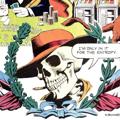A Cask of Troutwine reviewed Stray Toasters by Bill Sienkiewicz
None
4 stars
Sienkiewicz is firing on all cylinders here, with his work sliding between painting, comic art, collage and back as the situation requires. A lot of what makes this book work is his ability to produce striking images that capture the nightmarish world he's created.
The whole comic unfolds like a nightmare in what's implied to be a far future setting where most animals have died and been replaced. The cast are all caught up in their own neuroses as multiple killers are running about in a world that has lost almost all sense of empathy. Newscasts can barely stay on topic about horrific crimes while people prattle on about TV shows and home shopping, with one advertisement per chapter for bizarre toasters.
The story is a mix of a Jacobean revenge play, with a very Freudian take on psychology about our childhood development along with our obsessions with sex and …
Sienkiewicz is firing on all cylinders here, with his work sliding between painting, comic art, collage and back as the situation requires. A lot of what makes this book work is his ability to produce striking images that capture the nightmarish world he's created.
The whole comic unfolds like a nightmare in what's implied to be a far future setting where most animals have died and been replaced. The cast are all caught up in their own neuroses as multiple killers are running about in a world that has lost almost all sense of empathy. Newscasts can barely stay on topic about horrific crimes while people prattle on about TV shows and home shopping, with one advertisement per chapter for bizarre toasters.
The story is a mix of a Jacobean revenge play, with a very Freudian take on psychology about our childhood development along with our obsessions with sex and death, and a Burroughs-ian nightmare with hints of Philip K. Dick.
It might not be the most complicated narrative, but the book is such a perfectly cohesive whole that it's hard to really criticize that. The art feeds into writing which feeds back into the art. If I could criticize anything it would simply be that I wish the book was larger to really let you experience Sienkiewicz's art.


